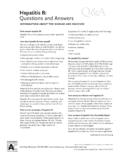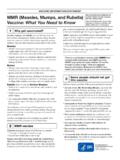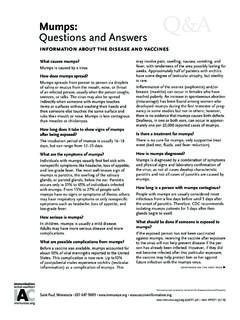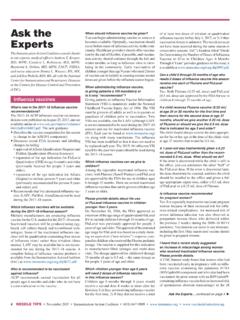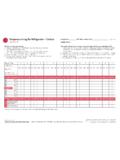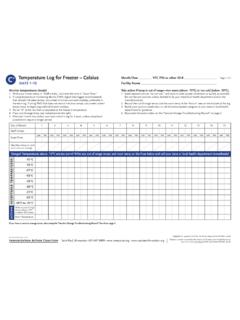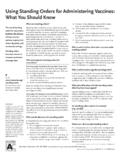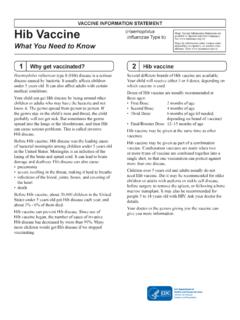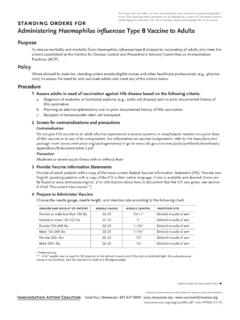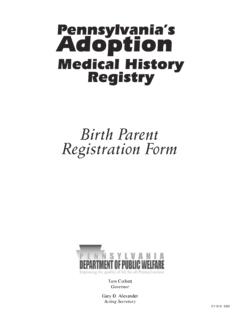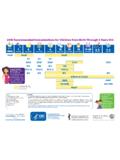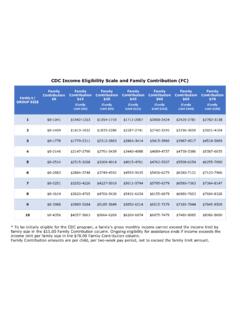Transcription of Sample Text for Developing Admission Orders in Newborn ...
1 Sample Text for Developing Admission Orders in Newborn Units for the hepatitis B vaccine birth dose Routine Orders for all newborns 1 Review a copy of the mother's original lab report to ensure that the correct serologic test (HBsAg) was ordered and that it was ordered during this pregnancy. Perform a repeat HBsAg blood test on the pregnant woman (mother) if she was HBsAg negative during a prenatal visit but was at risk for acquiring HBV infection during this pregnancy ( , more than one sex partner in the previous 6 months, evaluation or treatment for a sexually transmitted disease, recent or current injection-drug use, or HBsAg-positive sex partner), or had clinical hepatitis since her previous testing.
2 2 Determine if the Newborn is high risk and needs immediate postexposure prophylaxis within 12 hours of birth . The infant is high risk if the mother's HBsAg status is positive or unknown. For routine hepatitis B vaccination of normal weight infants: the mother is HBsAg negative 1 Administer single-antigen hepatitis B vaccine , pediatric, mL, intramuscular (IM), in anterolateral thigh within 24 hours of birth (or sooner if the infant is discharged before 24 hours). Prior to vaccination, give the parent a hepatitis B vaccine Information Statement and obtain verbal consent to vaccinate. Give the parent a record of the vaccination.
3 If parent is unwilling to give consent, notify physician ASAP. Document vaccine administration or vaccine refusal in hospital record. note: For infants weighing less than 2 kg ( lbs.), administer the vaccine at hospital discharge or by 1 month of age, whichever comes first. For highest-risk infants: the mother is HBsAg positive 1 Administer hepatitis B Immune Globulin (HBIG) mL, IM, in anterolateral thigh in the delivery room or ASAP within 12 hours of birth . Document HBIG administration in hospital record. Give parent a record of the HBIG dose . 2 At same time and in opposite anterolateral thigh, administer single-antigen hepatitis B.
4 vaccine , pediatric, mL, IM, ASAP within 12 hours of birth . Document vaccine administra- tion in hospital record. Give parent a record of the vaccination. 3 Prior to administering both HBIG and hepatitis B vaccine , give parent a hepatitis B vaccine Information Statement and obtain verbal consent to vaccinate. If parent unwilling to give consent, notify physician ASAP. Consider notifying Child Protective Services if parent contin- ues to refuse despite discussion with physician. 4 Notify the local or state health department of the infant's birth and the date and time of administration of HBIG and hepatitis B vaccine doses.
5 5 Obtain the name, address, and phone number of the Newborn 's primary care provider. 6 Notify primary care provider of Newborn 's birth , the date and time that HBIG and hepatitis B vaccine doses were administered, and the importance of additional on-time vaccination (infants weighing less than 2 kg ( lbs) will require 4 doses of vaccine as the first dose does not count ) and postvaccination testing of the infant for HBsAg and antiHBs (antibody to HBsAg) 1 2 months after completion of the hepatitis B vaccine series and no earlier than when the infant is 9 12 months of age. note: The optimal timing for serologic testing to detect a vaccine response generally is 1 2 months after the final dose of the HepB.
6 vaccine series. Results of tests for HBsAg can be transiently positive for 1 18 days after vaccination. Serologic testing should be performed no earlier than age 9 months to avoid detection of passive anti-HBs from hepatitis B immune globulin administered at birth and to maximize the likelihood of detecting late HBV infection. continued on the next page . Technical content reviewed by the Centers for Disease Control and Prevention Saint Paul, Minnesota 651- 647- 9009 Item #P2131 (6/18). Sample Text for Developing Admission Orders in Newborn Units for the Hep B vaccine birth dose (continued) page 2 of 2.
7 7 Provide advice to the mother. Tell her the following: a That she may breast-feed her infant upon delivery, even before hepatitis B vaccine and HBIG are given;. b It is critical for her infant to complete the full hepatitis B vaccine series on the recommended schedule;. c Blood tests (HBsAg and anti-HBs) will need to be obtained from the infant 1 2 months after completion of the hepatitis B vaccine series (at 9 12 months of age) to determine if the infant developed a protective immune response to vaccination or needs additional management;. d About modes of HBV transmission and the need for testing and vaccination of susceptible household, sexual, and needle-sharing contacts.
8 E She and other infected contacts need to have medical evaluations for chronic hepatitis B, including assessment to determine if they are candidates for antiviral treatment. For high-risk infants: the mother's HBsAg status is unknown 1 Administer single-antigen hepatitis B vaccine ( mL, IM) within 12 hours of birth . For infants weighing less than 2 kg ( lbs) at birth , also administer hepatitis B immune globulin (HBIG mL, IM) within 12 hours. Do not wait for test results to return before giving this dose of vaccine (and HBIG for infants weighing less than 2 kg [ lb]). Document vaccine administration in the hospital record.
9 Give the parent a record of the vaccination. 2 Confirm that the laboratory has received blood for the mother's HBsAg test. 3 Verify when the mother's HBsAg result will be available and that it will be reported to the Newborn unit ASAP. 4 If the laboratory test indicates the mother's HBsAg test result is positive, do the following: a Administer HBIG mL, IM, ASAP to the Newborn weighing 2 kg ( lb) or more. (Those weighing less than 2 kg ( lb) at birth should have already received HBIG.) ( hepatitis B vaccine should have been given within 12 hours of birth to all infants of mothers with unknown HBsAg status.)
10 B Follow steps 4 7 of the previous section (see For highest-risk infants: the mother is HBsAg positive ). reference CDC. Prevention of hepatitis B Virus Infection in the United States: Recommendations of the . Advisory Committee on Immunization Practices. MMWR, January 12, 2018;67(RR-1):1-30, available at For additional detailed information about text that you might incorporate into Newborn Admission Orders , including Orders for premature infants, refer to Guidance for Developing Admission Orders in Labor & Delivery and Newborn Units to Prevent hepatitis B Virus Transmission available at Immunization Action Coalition Saint Paul, Minnesota 651- 647- 9009 Item #P2131 (6/18).
